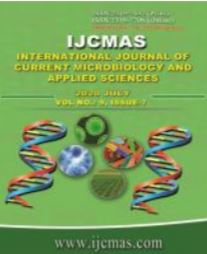


 National Academy of Agricultural Sciences (NAAS)
National Academy of Agricultural Sciences (NAAS)

|
PRINT ISSN : 2319-7692
Online ISSN : 2319-7706 Issues : 12 per year Publisher : Excellent Publishers Email : editorijcmas@gmail.com / submit@ijcmas.com Editor-in-chief: Dr.M.Prakash Index Copernicus ICV 2018: 95.39 NAAS RATING 2020: 5.38 |
Elephant foot yam [Amorphophallus paeoniifolius (Dennst.) Nicolson] competes with weeds throughout its growing period owing to its canopy orientation and wider spacing. Manual weeding is the most popular weed control method adopted in elephant foot yam irrespective of drudgery and labourious. A field experiment was conducted for two consecutive years (2016 and 2017) at the Regional Centre of Indian Council of Agricultural Research-Central Tuber Crops Research Institute, Bhubaneswar, Odisha, India to study the effects of polypropylene fabric ground cover (PFGC) on weed control in elephant foot yam. The treatment PFGC resulted in greater corm yield (34.2 tha-1)which was 253%higher over the weedy check, and 2.4 and 7.2% higher over 4 manual weedings at 30, 60, 90 and 120 days after planting (DAP) (33.4 tha-1) and 2 manual weedings at 30 and 60 DAP along with post-emergence application of glyphosate at 90 DAP (31.9 tha-1), respectively. The treatment PFGC resulted in greater gross income (Rs 513000 ha-1) and profit (Rs287500 ha-1) compared to other treatments. Use of PFGC resulted in greater populations of fungi, bacteria and actinomycetes, and enzymes of dehydrogenase, fluorescein diacetate, acid and alkaline phosphatase activities in post harvest soil than initial value that indicated the treatment PFGC could be a good weed control option in elephant foot yam.
 |
 |
 |
 |
 |